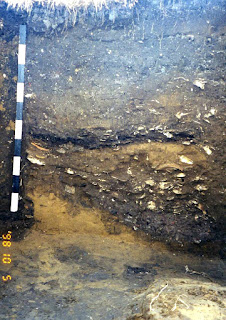Crawling through St. Augustine Archaeology: Week 1, the 16th Century
Every October, we traditionally host our St. Augustine Archaeology Pub Crawl to celebrate International Archaeology Day. Unfortunately, this year we are unable to host the event due to restrictions on public events because of the global pandemic. However, we'll be bringing you a virtual crawl through the City's archaeology through a weekly series featuring archaeological research, links to more resources, and fun beverage pairings. Keep your eyes peeled for a new post every Friday.
Check out the whole series:
This week, we'll kick off the series with a look at 16th Century sites in St. Augustine.
The Sites
The City of St. Augustine was founded by Pedro Menendez and a group of Spaniards in 1565. While the current city limits include the original settlement, the 16th century settlement included three different locations. The first is located at today's Fountain of Youth Archaeological Park.
Archaeologist Kathy Deagan and the University of Florida/Florida Museum have been working at this site for longer than we'll admit (to be polite!). She's uncovered the remains of a Timucuan village named Seloy and evidence that Menedez and his crew moved in in 1565. The site contains numerous building remains, barrel wells, and lots of European trade goods.
 |
| Map of archaeological investigations at the Fountain of Youth Archaeological Park. Photo: Florida Museum. |
 |
| Excavations at the Park. Photo: Florida Museum. |
You can read more about the Fountain of Youth at the Florida Museum of History's digital exhibit.
After a few months living in the modified Timucuan village, the Spanish moved to Anastasia Island. The exact location of this settlement is still unknown. In 1572, the settlement moves to today's downtown location. Archaeological deposits from these original houses and buildings can be found south of the plaza along Charlotte and Aviles Streets.
 |
| Photo: City of St. Augustine. |
 |
| Photo: City of St. Augustine |
 |
| Drawing of what the church probably looked like. Drawing by E Gordon. |
 |
| If you take a stroll on Aviles Street, you can find these markers representing the posts of the church. |
 |
| Burned layer in a test unit at the Art Association. Photo: City of St. Augustine. |
 |
| View of the cache of household goods found under the burnt layer. Photo: City of St. Augustine. |
The beverage
The early Spanish settlers brought wine with them to La Florida. Historic documents tell us Menendez bought 720 botija peruleras of wine for the founding expedition. Each botija held around 3 gallons of wine - that's at least 11,000 bottles of wine by today's standard! So we recommend a nice Spanish wine to pair with your archaeological explorations this week. Or maybe something made a little closer to home like a bottle from St. Augustine's own San Sebastian Winery.
 |
| Botija, commonly called olive jars, recovered from excavations at the Fountain of Youth. Photo: Florida Museum. |
For more exciting 16th century sites, check out this blog post.
Text and images by Emily Jane Murray unless otherwise noted.